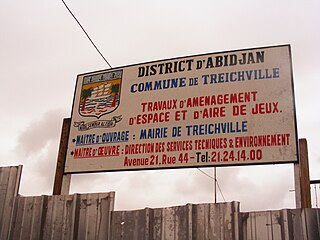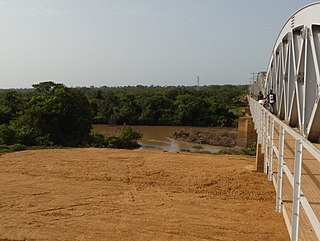
On 6 September 2016, the railway bridge over the Nzi River collapsed, cutting the rail link between Ivory Coast and Burkina Faso. Partial services on the line resumed on 10 September, with repairs estimated to take about two weeks.

On 6 September 2016, the railway bridge over the Nzi River collapsed, cutting the rail link between Ivory Coast and Burkina Faso. Partial services on the line resumed on 10 September, with repairs estimated to take about two weeks.
The Nzi River Bridge is a 250 metres (820 ft) steel railway bridge over the Nzi River near Dimbokro in Ivory Coast, built in 1910. It carries the single-track railway between Abidjan and Ouagadougou and also a foot bridge, and consists of a single span crossing the river flanked by smaller spans crossing the floodplain. According to local residents, it was rusty and in a poor state of repair. [1] [2] The rail link is operated by Sitarail.
On 6 September 2016, one of the approach spans collapsed while a two-engined goods train was attempting to leave the bridge in the direction of Burkina Faso. The train consisted of 20 or 21 wagons with a load of more than 1000 tons, which remained on the bridge. [1] [3] The accident cut the rail link between the two countries, which is important to their economies. [1] [4] While most reports say that no-one was injured, one report says that the two train drivers were injured. [3]
The two engines are numbered CC 22105 and CC 22008. [2] They are class GT22LC-2 from GMD and have a Co-Co wheel arrangement with 6 axles (12 wheels).
In addition to interrupting railway traffic, the accident destroyed the pedestrian connection for local residents, who started to use small boats to ferry goods and people across the river. [1]
One local source suggested that the bridge had been destabilised when the arm of a bulldozer hit it, and that this may have caused the accident. [2]
Repairs were expected to cost £400 million [2] and take two weeks to complete. [4]
By 14 September, the two locomotives had been lifted by heavy-duty cranes onto a road trailer. [5] Temporary fill was put in place, armoured with gabions, and the damaged span removed.
Partial services on the line resumed on 10 September, with container goods being transported by a combination of rail and lorry. [6]

Transport in Burkina Faso consists primarily of road, air and rail transportation. The World Bank classified country's transportation as underdeveloped but noted that Burkina Faso is a natural geographic transportation hub for West Africa.

Ivory Coast invested remarkably in its transport system. Transport Infrastructures are much more developed than they are other West African countries despite a crisis that restrained their maintenance and development. Since its independence in 1960, Ivory Coast put an emphasis on increasing and modernizing the transport network for human as well as for goods. Major infrastructures of diverse nature were built including railways, roads, waterways, and airports. In spite of the crisis, neighbor countries still strongly depend on the Ivorian transport network for importing, exporting, and transiting their immigrants to Ivory Coast.

Ouagadougou or Wagadugu is the capital of Burkina Faso, and the administrative, communications, cultural and economic centre of the nation. It is also the country's largest city, with a population of 2,415,266 in 2019. The city's name is often shortened to Ouaga. The inhabitants are called ouagalais. The spelling of the name Ouagadougou is derived from the French orthography common in former French African colonies.

Bobo-Dioulasso is a city in Burkina Faso with a population of 1,129,000 ; it is the second-largest city in the country, after Ouagadougou, Burkina Faso's capital. The name means "home of the Bobo-Dioula".

Koudougou is a city in Burkina Faso's Boulkiemdé Province. It is located 75 kilometres (47 mi) west of Ouagadougou, the capital of Burkina Faso. With a population of 160,239 (2019), it is the third most populous city in Burkina Faso after Ouagadougou and Bobo Dioulasso, and is mainly inhabited by the Gurunsi and Mossi ethnic groups. Koudougou is situated on the only railway line in Burkina Faso and has some small industries, a market, a university and provincial government offices.

Banfora is a city in southwestern Burkina Faso, with a population of 117,452 making it the sixth most populous city in Burkina Faso. It is the capital of the Comoe province. The city lies 85 kilometres (53 mi) south-west of Bobo-Dioulasso, on the Abidjan – Ouagadougou Railway. The Cascades de Karfiguéla are a series of waterfalls close to Banfora.

Dimbokro is a town in south-central Ivory Coast. It is the seat of both Lacs District and N'Zi Region. It is also the seat of and a sub-prefecture of Dimbokro Department. Dimbokro is also a commune.
AfricaRail is a project to link the railway systems of Ivory Coast, Burkina Faso, Niger, Benin and Togo. These are all 1,000 mm gauge.

Treichville is a neighborhood in Abidjan, Ivory Coast. It is one of the 10 urban communes of the city. Treichville is one of four communes of Abidjan that are entirely south of Ébrié Lagoon, the others being Port-Bouët, Koumassi, and Marcory.

There are 622 kilometres of 1,000 mmmetre gauge railway in Burkina Faso, which run from Kaya to the border with Côte d'Ivoire and is part of the Abidjan-Ouagadougou railway. As of June 2014, 'Sitarail' operates a passenger train three times a week along the route from Ouagadougou to Abidjan. Journey time is 43 to 48 hours.

Ivory Coast has 660 kilometres of railway. The track gauge is 1,000 mm.
Victor Démé was a Burkinabé musician and singer-songwriter originating from a Mandinka family. His death was caused by a bout of malaria.
On 21 October 2016, a Camrail inter-city passenger train travelling from Cameroon's capital, Yaoundé, to its largest city, Douala, derailed in Eséka, Centre Region. By 30 October 2016, the official number of casualties had reached 79 dead, with 550 injured. It was the deadliest rail crash on the African continent since the August 2007 Benaleka train accident.

The Nzi River or N'zi River is a river in Ivory Coast. It is a tributary of the Bandama River.
Sitarail is a private company that has the concession to operate railway lines formerly operated by national governments in West and Central Africa. Countries include:

Burkina Faso–Spain relations are the bilateral and diplomatic relations between these two countries. Burkina Faso does not have an embassy in Spain, but its embassy in Paris, France, is accredited to Spain. and consulates in Almería, Barcelona, Madrid and Valencia. Spain has no embassy in Burkina Faso, but its embassy in Abidjan, Ivory Coast is accredited to Burkina Faso, and a consulate in Ouagadougou.
Sandra Pierrette Kanzié is a poet and the first woman from Burkina Faso to be published.

The Abidjan-Niger Railway is a 1,260-kilometre (780-mile) single-track metre gauge line in francophone West Africa that links Abidjan, the economic capital of Ivory Coast to Ouagadougou, the capital of Burkina Faso. The railway, like others on the continent, was constructed by the colonial power to encourage economic development in the region, although detractors would claim that it was to exploit the region solely for their own advantage.